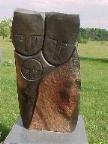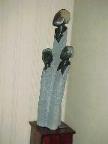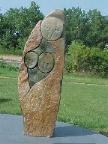![]()
![]()
The idea of family is a topic much explored and much narrated and much depicted in the art and literature of Post-Colonial Zimbabwe. The notion of family indeed plays a key role in the culture and the life of the Shona people. Despite the seeming centrality and importance of family in Shona culture, sculptors and authors have varied immensely in their representation of this idea. Two such sculptors are Henry Munyaradzi and Joe Mutasa. Both artists have sculpted beautiful works of art that are vastly different from one another yet these sculptures have the same name.
 In Munyaradzi's Family, the features of each family member is
almost identical, with each face differing only in size and their location
on the Serpentine rock. The faces have perfect circles for eyes,
rectangular noses, and no mouths, a style typical throughout all of his
sculptures. The two faces on the upper half of the sculpture represent the
parents, while the smaller face below them represents the child under the
protective care of his parents. In addition, the "family" seems bundled
together away from the rough surfaces of the Serpentine, which would come
to symbolize the disorder, chaos, and possibly even danger of the outside
world. The father, whom Munyaradzi depicts as having the largest face, is
closest to this disorder, representing his role in protecting both his wife
and his child. The similarity and proximity of the faces represent the
unity of family, the importance of togetherness in family, and family as
the singularly most important ideal amidst the disorder and chaos of
Zimbabwean society.
In Munyaradzi's Family, the features of each family member is
almost identical, with each face differing only in size and their location
on the Serpentine rock. The faces have perfect circles for eyes,
rectangular noses, and no mouths, a style typical throughout all of his
sculptures. The two faces on the upper half of the sculpture represent the
parents, while the smaller face below them represents the child under the
protective care of his parents. In addition, the "family" seems bundled
together away from the rough surfaces of the Serpentine, which would come
to symbolize the disorder, chaos, and possibly even danger of the outside
world. The father, whom Munyaradzi depicts as having the largest face, is
closest to this disorder, representing his role in protecting both his wife
and his child. The similarity and proximity of the faces represent the
unity of family, the importance of togetherness in family, and family as
the singularly most important ideal amidst the disorder and chaos of
Zimbabwean society.
 Mutasa, on the other hand, chooses to depict his version of
Family differently. The first noticeable difference is the unique
detail given to each member of the family. Mutasa gives each person
distinct facial features, going so far as to particularize the texture of
their hair. In addition, the family is not huddled together as in
Munyaradzi's sculpture but rather possess their individual pedestals of
Springstone. Finally, the vertical alignment of each of the three faces
gives the impression that the hierarchical nature of family is more
important than the protective nature as in Munyaradzi's sculpture. The
uppermost person could then be that of a single parent or an elder brother
or sister, defined by his superiority and authority rather than his
responsibility to protect his/her younger siblings/children.
Mutasa, on the other hand, chooses to depict his version of
Family differently. The first noticeable difference is the unique
detail given to each member of the family. Mutasa gives each person
distinct facial features, going so far as to particularize the texture of
their hair. In addition, the family is not huddled together as in
Munyaradzi's sculpture but rather possess their individual pedestals of
Springstone. Finally, the vertical alignment of each of the three faces
gives the impression that the hierarchical nature of family is more
important than the protective nature as in Munyaradzi's sculpture. The
uppermost person could then be that of a single parent or an elder brother
or sister, defined by his superiority and authority rather than his
responsibility to protect his/her younger siblings/children.
How do these representations of family compare to those depicted in the Post-Colonial literature of Zimbabwe? One novel that best incorporates both Munyaradzi's and Mutasa's notions of family is Tsitsi Dangarembga's Nervous Conditions. This novel explores the growth of a child, Tambudzai, from the failure of one family to the success of another family. As a young child, Tambu is immersed in the failure of her own biological parents and subjugated by the intellectual and familial superiority of her older brother Nhamo. In this respect, Tambu's family fails in her protection and nurturing and even goes as far as to oppose her own attempts to better herself by selling mealies in the city to pay for her education. Antwan Jefferson's essay entitled The Father's Failure explicates the failure of Tambu's parents and her subsequent desire to project the idea of family onto her uncle. He asks the question whether Jeremiah's failure relegates his role in the idea of family or excludes him from the idea of family altogether. Whether Jeremiah willingly relinquishes his role as the head family member with respect to Tambu is irrelevant, for Tambu herself looks to Babamukuru as the authority figure and protector.
 Another sculpture from Munyaradzi's collection merits analysis. His
Good Samaritan more closely resembles Mutasa's Family
strictly concerning the vertical placement of each of the members. Both
have only one authority figure at the top of the sculpture, each serving as
a guide or an authority figure to the others placed below them. Babamukuru
in Nervous Conditions serves as this authority figure in the novel,
taking in Tambu as if she were his biological daughter, supporting her, and
providing her with an excellent educational opportunity. At first glance,
it would seem as though Babamukuru is the "Good Samaritan," providing the
needy members of his family an opportunity to improve both in their
financial and social situations. However, one could also argue that
Babamukuru more closely resembles the head figure in Mutasa's sculpture,
having very little filial compassion but rather using his revered status as
a guide and also as a symbol of authority in his family.
Another sculpture from Munyaradzi's collection merits analysis. His
Good Samaritan more closely resembles Mutasa's Family
strictly concerning the vertical placement of each of the members. Both
have only one authority figure at the top of the sculpture, each serving as
a guide or an authority figure to the others placed below them. Babamukuru
in Nervous Conditions serves as this authority figure in the novel,
taking in Tambu as if she were his biological daughter, supporting her, and
providing her with an excellent educational opportunity. At first glance,
it would seem as though Babamukuru is the "Good Samaritan," providing the
needy members of his family an opportunity to improve both in their
financial and social situations. However, one could also argue that
Babamukuru more closely resembles the head figure in Mutasa's sculpture,
having very little filial compassion but rather using his revered status as
a guide and also as a symbol of authority in his family.
Despite the fact that one can interpret the notions of family so vastly in a single novel, can one also resolve these widely varying representations of family in both sculpture and literature into a coherent, workable model? Do we have to accept one idea over another? It would seem that in Dangarembga's novel and the two artists' works, their representations of family might have a fundamental similarity but vary in their emphasis of what is important for a family's function.
Other Discussions of Zimbabwean literature and sculpture.